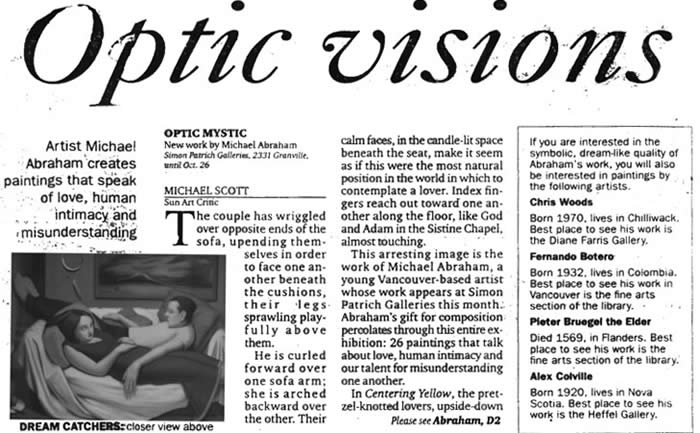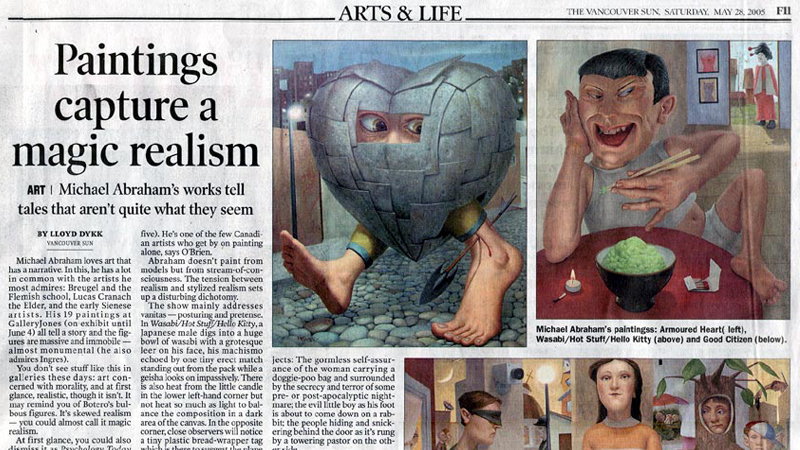Articles, Reviews, Writing…
(Last update: February 2018, with the addition of Ian Tan Gallery’s writing at bottom of this page)
Jan Baum – on Michael Abraham – Arena show, May 2007.
Social commentary and satire have a long tradition in the history of art. Bosch – whose revelations are striking while his exuberant imagination never fails to exhilarate us. Goya – whose prodding of the royal family is usually noticed outside of the court and even outside of Spain. Closer to our time, the English satirist Hogarth, of a “Rakes Progress,” as well as the literary Galsworthy, chide English society with subtle subterfuge. So into this arena steps Michael Abraham, a native of Canada, who lives in Vancouver, British Columbia, and has been exhibiting since 1992. His paintings are both charming and disarm
ing. With a mischievous grin he wields his imagination on canvas. A warrior for tolerance and understanding – hope and joy, he means what he paints. Michael Abraham says he deals less in social commentary more in psychological realism. He shares his perceptions and incites with a good sprinkle of humor. The slight distortion of the figures percolates to the actions, which are mild to manic. Though helplessly terrorized as we confront his images, basically we know he means well, and like Breughel, he points to the indisputable foibles of mankind. Merging the inner and outer experience with creative freedom, he does not send it out like fast food – more important, is for the viewer to relate to the work, in their unique and individual way and in their own time. If he can illuminate the dark corridors of our journey, he is requited and we are the beneficiaries. And, finally, he tells us “My art is my sorrow, my hope, my prayer and my joy.”
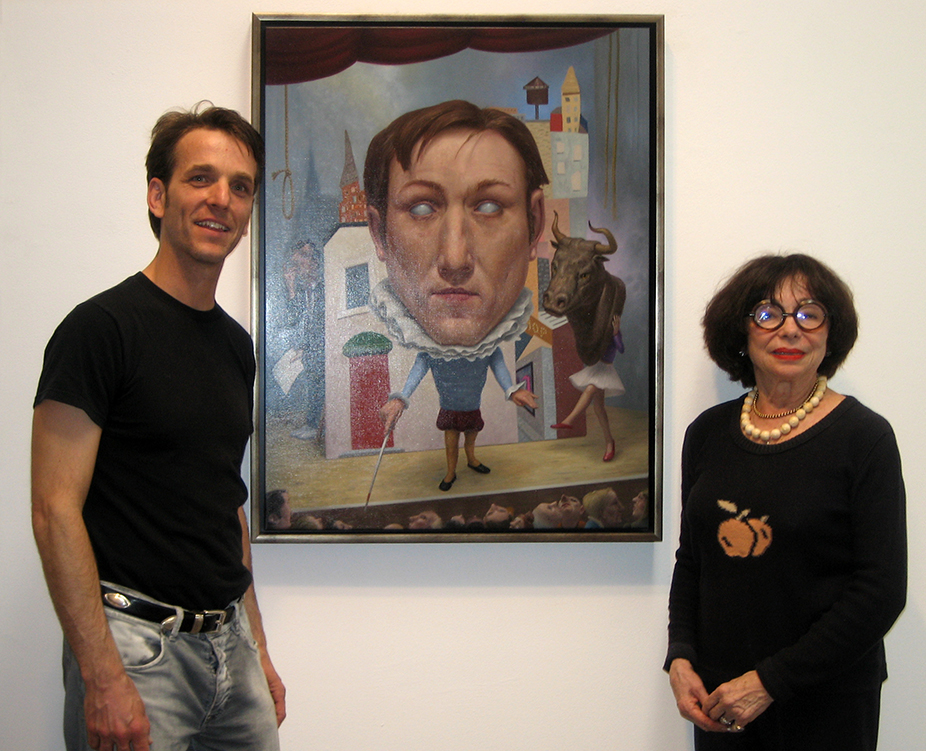
With Jan, at Jan Baum Gallery, Los Angeles 2007
Review by Michael Scott, Vancouver Sun, May 2001.
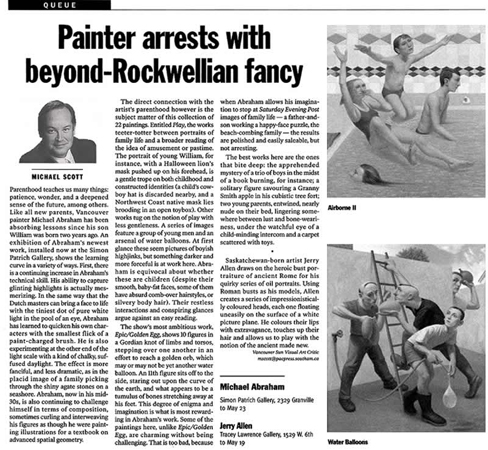
Painter arrests with beyond-Rockwellian fancy…
Parenthood teaches us many things: patience, wonder, and a deepened sense of the future, among others. Like all new parents, Vancouver painter Michael Abraham has been absorbing lessons since his son William was born two years ago. An exhibition of Abraham’s newest work, installed now at the Simon Patrich Gallery, shows the learning curve in a variety of ways. First, there is a continuing increase in Abraham’s technical skill. His ability to capture glinting highlights is actually mesmerizing. In the same way that the Dutch masters can bring a face to life with the tiniest dot of pure white light in the pool of an eye, Abraham has learned to quicken his own characters with the smallest flick of a paint-charged brush. He is also experimenting at the other end of the light scale with a kind of chalky, suffused daylight. The effect is more fanciful, and less dramatic, as in the placid image of a family picking through the shiny agate stones on a seashore. Abraham, now in his mid-30s, is also continuing to challenge himself in terms of composition, sometimes curling and interweaving his figures as though he were painting illustrations for a textbook on advanced spatial geometry.
The direct connection with the artist’s parenthood however is the subject matter of this collection of 22 paintings. Entitled Play, the works teeter-totter between portraits of family life and a broader reading of the idea of amusement or pastime. The portrait of young William, for instance, with a Halloween lion’s mask pushed up on his forehead, is a gentle trope on both childhood and constructed identities (a child’s cowboy hat is discarded nearby, and a Northwest Coast native mask lies brooding in an open toybox). Other works tug on the notion of play with less gentleness. A series of images feature a group of young men and an arsenal of water balloons. At first glance these seem pictures of boyish highjinks, but something darker and more forceful is at work here. Abraham is equivocal about whether these are children (despite their smooth, baby-fat faces, some of them have absurd comb-over hairstyles, or silvery body hair). Their restless interactions and conspiring glances argue against an easy reading.
The show’s most ambitious work, Epic/Golden Egg, shows 10 figures in a Gordian knot of limbs and torsos, stepping over one another in an effort to reach a golden orb, which may or may not be yet another water balloon. An 11th figure sits off to the side, staring out upon the curve of the earth, and what appears to be a tumulus of bones stretching away at his feet. This degree of enigma and imagination is what is most rewarding in Abraham’s work. Some of the paintings here, unlike Epic/Golden Egg, are charming without being challenging. That is too bad, because when Abraham allows his imagination to stop at Saturday Evening Post images of family life — a father-and-son working a happy-face puzzle, the beach-combing family — the results are polished and easily saleable, but not arresting.
The best works here are the ones that bite deep: the apprehended mystery of a trio of boys in the midst of a book burning, for instance; a solitary figure savouring a Granny Smith apple in his cubistic tree fort; two young parents, entwined, nearly nude on their bed, lingering somewhere between lust and bone-weariness, under the watchful eye of a child-minding intercom and a carpet scattered with toys.
-Michael Scott, Vancouver Sun Visual Art Critic mscott@pacpress.southam.ca
‘Play’ – Solo exhibition at Simon Patrich Gallery, 2329 Granville, May 2001.
Review by Michael Harris, Vancouver Sun, May 2003.
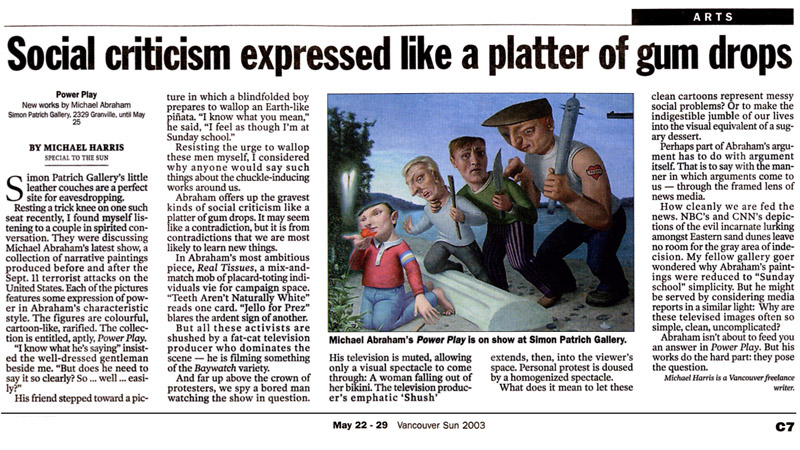
Social Criticism Expressed Like a Platter of Gum Drops
Simon Patrich Gallery’s little leather couches are a perfect site for eavesdropping. Resting a trick knee on one such seat recently, I found myself listening to a couple in spirited conversation. They were discussing Michael Abraham’s latest show, a collection of narrative paintings produced before and after the Sept. 11 terrorist attacks on the United Slates. Each of the pictures features some expression of power in Abraham’s characteristic style. The figures are colourful, cartoon-like, rarified. The collection is entitled, aptly, Power Play. “I know what he’s saying” insisted the well-dressed gentleman beside me. “But does he need to say it so clearly? So… well… easily?
His friend stepped toward a picture in which a blindfolded boy prepares to wallop an Earth-like piñata. “I know what you mean, he said, “I feel as though I’m at Sunday school.”
Resisting the urge to wallop these men myself, I considered why anyone would say such things about the chuckle-inducing works around us.
Abraham offers up the gravest kinds of social criticism like a platter of gum drops. It may seem like a contradiction, but it is from contradictions that we are most likely to learn new things.
In Abraham’s most ambitious piece, Real Tissues, a mix-and-match mob of placard-toting individuals vie for campaign space. “Teeth Aren’t Naturally White” reads one card. “Jello for Prez” blares the ardent sign of another.
But all these activists are shushed by a fat-cat television producer who dominates the scene — he is filming something of the Baywatch variety.
And far up above the crown of protesters, we spy a bored man watching the show in question. His television is muted, allowing only a visual spectacle to come through: A woman falling out of her bikini. The television producer’s emphatic ‘Shush’ extends, then, into the viewer’s space. Personal protest is doused by a homogenized spectacle.
What does it mean to let these clean cartoons represent messy social problems? Or to make the indigestible jumble of our lives into the visual equivalent of a sugary dessert. Perhaps part of Abraham’s argument has to do with argument itself. That is to say with the manner in which arguments come to us — through the framed lens of news media. How cleanly we are fed the news. NBC’s and CNN’s depictions of the evil incarnate lurking amongst Eastern sand dunes leave no room for the gray area of indecision. My fellow gallery goer wondered why Abraham’s paintings were reduced to “Sunday school” simplicity. But he might be served by considering media reports in a similar light: Why are these televised images often so simple, clean, uncomplicated?
Abraham isn’t about to feed you an answer in Power Play. But his works do the hard part: they pose the question.
-Michael Harris is a Vancouver Freelance writer.
Power Play – New works May 2003 at Simon Patrich Gallery, Vancouver.
Review By Michael Scott, Vancouver Sun Art Critic, October 1996.
“Artist Michael Abraham creates paintings that speak of love, human intimacy and misunderstanding”.
The couple has wriggled over opposite ends of the sofa, upending themselves in order to face one another beneath the cushions, their legs sprawling playfully above them. He is curled forward over one sofa arm; she is arched backward over the other. Their calm faces, in the candle-lit space beneath the seat, make it seem as if this were the most natural position in the world in which to contemplate a lover. Index fingers reach out toward one another along the floor, like God and Adam in the Sistine Chapel, almost touching.
This arresting image is the work of Michael Abraham, a young Vancouver-based artist whose work appears at Simon Patrich Galleries this month. Abraham’s gift for composition percolates through this entire exhibition: 26 paintings that talk about love, human intimacy and our talent for misunderstanding one another.
In Centering Yellow, the pretzel-knotted lovers, upside-down over their sofa are balanced in the most precise and enigmatic way. One finger wrong, and the whole arrangement might slide out of true. That dynamic stasis energizes the rest of the canvas, which reveals a make-believe Mondrian on the wall above the sofa, which in turn mirrors the candle that stands on the floor.
“I’ve been working hard on composition.” the artist says modestly, oblivious to the genius evident in some of these paintings. He is filled with nervous energy, amiable.
“When things happen that I don’t understand, I’ll explore them in my art,” he says.
Mixed messages from friends, for instance, find expression in a series of images with many-armed, Shiva-like figures. In Twilight Walking, for instance, a woman walks her dogs down a narrow path, the sky glowing twilight above her. The six dogs are a happy, motley crew. The woman is very plain, ordinary even, except for the fact she has six arms, one for each leash. Each hand tells its own story; one is the picture of daintiness, with pinky extended, another is a ferocious fist, another is playing its dog like a yo-yo.
The message is even more pointed in … but my hands are tied. Here, a male figure with eight arms sits oracle-like in a streetside niche. A young boy stands in front with a request: and each arm provides a little more information about the interior life of the character Two arms are, indeed, tied. But a third that points to this might just as easily untie them. Another hand is raised in a gesture of helplessness, yet another curls behind the man’s back, where it crosses its fingers, and another sprawls in nonchalance.
The streetscape is de Chirico-like, full of enigmatic plazas and streets that run into a maze.
And then there’s the sky — a wild sunset of magenta and blue, punctuated by square towers and distant trees. The Renaissance feel is intentional: Abraham spent a year in Florence where he was deeply influenced by the art treasures he found there. Many of his works evoke similar landscapes.
Sidewalk, for instance, a fish-eye view of a suburban street and a floating figure in Birkenstocks, still shows a line of hills and cypress trees on the horizon.
Waiting for Reception has a glowing Renaissance quality of its own. But instead of halos of saintliness, the characters here are bathed in the eerie glow of television sets.
Abraham’s imagination is spellbinding. There are canvases that teem with the carnal crowds of Bruegel; others in which a single figure holds the eye enthralled. A nude beach north of Lion’s Bay becomes a latter-day meeting of nymphs and satyrs. A beachcomber in another painting takes on the attitude and mien of a Transfiguration, serene-looking, draped in simplified garments.
Abraham’s exhibition is nearly sold out, which is no surprise given the artist’s talent and his modest prices. But even without the prospect of purchase, these sensational paintings are well worth seeing. The exhibition continues through Oct. 26, 1996.
OPTIC MYSTIC – New work by Michael Abraham, at Simon Patrich Gallery, Vancouver.
-Michael Scott, Vancouver Sun Visual Art Critic mscott@pacpress.southam.ca
Review by Lloyd Dyck, Vancouver Sun, May 2005.
Paintings Capture a Magic Realism.
Art / Michael Abraham’s works tell tales that aren’t quite what they seem.
Michael Abraham loves art that has a narrative. In this, he has a lot in common with the artists he most admires: Breughel and the Flemish school, Lucas Cranach the Elder, and the early Sienese artists. His 19 paintings at Gallery Jones (on exhibit until June 4) all tell a story and the figures are massive and immobile — almost monumental (he also admires Ingres).
You don’t see stuff like this in galleries these days: art concerned with morality, and at first glance, realistic, though it isn’t. It may remind you of Botero’s bulbous figures. It’s skewed realism — you could almost call it magic realism.
At first glance, you could also dismiss it as Psychology Today illustration but it’s more, with its densely encrypted symbols. It’s loaded with them. About half the visitors to his show make a quick tour and give it a dismissive “ehh,” Abraham says. Alex Colville wasn’t so quick to judge, calling his work “contemplative, meditative.” The show’s not built for speed. Abraham calls it The Other Side. It may represent the other side of him, since he just turned 40. The night before, he worked out. Though fit looking, he’s not a gym junkie.
He was born in Montreal and began studies in life drawing and composition at the Ontario College of Art. In 1990 he spent a year studying in Florence, Italy, where he also worked as a teaching assistant, fife inoveu1 to Vancouver and for about 13 years showed at the Simon Patrich Gallery. Recently he moved to the Jones, and changing galleries is always a big step for an artist.
The mandate of the gallery, says owner Shane O’Brien, is to bring Canadian art into the international scene — the Jones, at 1725 West Third, has been open only a year. Abraham has been collected by purchasers from New York, London, Singapore and Los Angeles (Courtenay Cox and David Arquette have two of his works, one of them about four feet by five). He’s one of the few Canadian artists who get by on painting alone, says O’Brien.
Abraham doesn’t paint from models but from stream-of-consciousness. The tension between realism and stylized realism sets up a disturbing dichotomy. The show mainly addresses vanitas — posturing and pretense. In Wasabi/Hot Stuff/Hello Kitty, a Japanese male digs into a huge bowl of wasabi with a grotesque leer on his face, his machismo echoed by one tiny erect match standing out from the pack while a geisha looks on impassively. There is also heat from the little candle in the lower left-hand corner but not heat so much as light to balance the composition in a dark area of the canvas. In the opposite corner, close observers will notice a tiny plastic bread-wrapper tag, which is there to suggest the plane of the floor.
“They’re not decorative, are they?” I say to Abraham, who is light-hearted and enjoyably chatty. “They would be in my house,” he says.
I don’t know that I could live with the fear that paralyses the eyes in Armoured Heart, a figure galvanized by protective metal in a heart shape. The eyes are the only feature you see but for the legs, one of them bloody from the medieval-looking lance that impales it. The possibility of protection, whether against forces too big or unknowable to reckon with, including emotion, may be one of the myths we tell ourselves.
Abraham has no problem with titling each work to offer the viewer a point of entry. Everything he paints is beautifully constructed, sometimes with a Renaissance-like illusion that makes it seem possible to reach out and move a detail. His paintings are made for artificial light — he paints at night under halogen. Artificial light brings out warmth. Painting in natural light brings out coolness.
There’s nothing cool about Abraham’s perfervid work except for the implacable facial expressions of most of his subjects: The gormless self-assurance of the woman carrying a doggie-poo bag and surrounded by the secrecy and terror of some pre- or post-apocalyptic nightmare; the evil little boy as his foot is about to come down on a rabbit; the people hiding and snickering behind the door as it’s rung by a towering pastor on the other side.
But Hypnotica, a huge work depicting what seems to be revivalistic charlatans and the masses they draw, is a Breugelian revel. You may miss the MacDonald’s M in the background. “You can’t stop marketing — the marketeers, the PR people,” Abraham says. We’re like moths to the flame, the flame being advertising, which infects everything from the news to game shows like Jeopardy. Nor, it seems, can you stop the Faustian delusions of grandeur of the companies that think they have a patent on nature. Mia Santa, The Strong Arm of the Maw, is a pun on Monsanto: the statuesque old woman who collars the man walking down the road zealously guarding a bag of seeds is a reference to his great aunt in the east end of Montreal.
“We live in a democracy but it’s still the land of kings,” Abraham notes drily. (Ozymandias: “look on my works, ye mighty, and despair.”)
Not that there isn’t humor in Abraham’s work, otherwise it would be too dreadful. I enjoyed the quotation from Carl Jung that accompanied a piece from an earlier show: “Everything that irritates us about others can lead to an understanding of ourselves.”
Writing From Preview Magazine:
Michael Abraham: Apologues
Art Gallery at Evergreen Cultural Centre Coquitlam BC – Jul 20-Aug 31, 2013

Michael Abraham is a popular Vancouver artist who creates fanciful images in a magic realism style. Formerly represented by the Simon Patrich Gallery for 13 years, he was taken on by Gallery Jones in 2006. After numerous solo exhibitions of Abraham’s work in Vancouver, Apologues is his first public gallery retrospective of his work. Born in Montreal, Michael Abraham studied first at the Ontario College of Art during the 1980s and subsequently in Florence, Italy. Like an eclectic mix of Rousseau, Dali, Breugel and Bosch, Abraham’s paintings are flavoured by a fairytale sensibility with exaggerated people, fantastic animals, enchanted gardens and mythical landscapes. The surreal qualities of the scenes are emphasized by the vacuous expressions of his subjects – often including himself as model – and their strangely smooth skin and clothes. Playful at first glance, the bizarre images often carry darker undertones of madness and chaos. Displaying what reviewers have described as “skewed realism,” “enigma and imagination,” and “whimsy, bemusement and contrasting veracity,” the paintings are heavily symbolic and rife with dense allusions to both public life and private reveries. www.evergreenculturalcentre.ca
– Mia Johnson for Preview Magazine, June 2013.
Press Release: Evergreen Cultural Centre, June 2013.
MICHAEL ABRAHAM explores modern APOLOGUES
in a fanciful and socially critical retrospective
at the Art Gallery at Evergreen Cultural Centre
July 20 – August 31, 2013
COQUITLAM, BC (JUNE 27, 2013) – BC artist Michael Abraham livens up the Art Gallery at Evergreen this summer with bold, colourful and irreverent paintings and sculptures that hold a funhouse mirror up to society, politics and human behaviour. ‘Apologues’, which takes its name from the storytelling quality of the exhibition, features a retrospective of over two decades of Abraham’s work.
An apologue is a brief story that is similar to a fable or parable, but differs in that it uses rhetorical arguments and exaggeration to sway the viewer in a moral direction without explicitly stating its intention. Like his title suggests, Abraham does not aim for realism, and instead uses abstraction to observe society and politics at play with a phenomenological and psychological slant. Without passing judgment, he visualizes catch-phrases, metaphors and parables with whimsy, bemusement and contrasting veracity in order to engage with his audience and encourage them to question and laugh at their daily context.
– Astrid Heyerdahl, Visual Arts Manager, Art Gallery at Evergreen Cultural Centre, 2013.
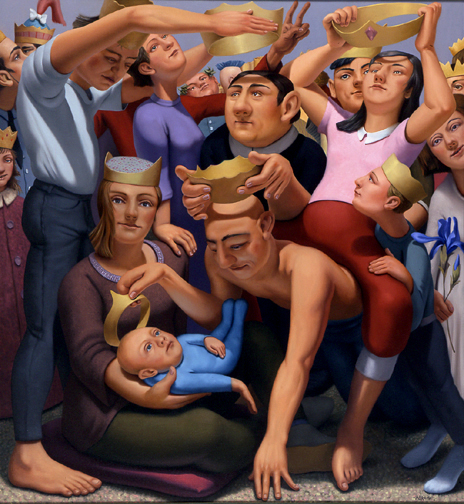
Press release:
The Lure – 2014 – at Gallery Jones, Vancouver
Written by Shane O’Brian – Gallery Jones Vancouver, Director
Opening reception: Thursday, June 5, 6-9pm, with musical guest Tonye Aganaba
Exhibition dates: June 5 – 28, 2014
Michael Abraham has been a successful full-time artist for over two decades with a history of dramatic invention, and a popular motif of his is that of material desire. His new exhibition, titled ‘The Lure’, delivers a complex and multi-faceted examination of the human condition of wanting in a series of beautifully painted canvases that echo the epic works of Renaissance art, images that are so loaded with the metaphysical.
As a title, ‘The Lure’ epitomizes what Abraham is wrestling with through his narrative paintings. Read as a noun, it is not difficult to see what the lure is in several of the storylines depicted. To describe the paintings themselves as alluring, which they are, implicitly challenges the promise of easy satisfaction, especially given the darker aspect of some of the narrative content. This seems to be essential to the overall practice that Abraham has been engaged in over his artistic career: can there ever been a satisfying resolution to the human condition of desire and longing?
This latent anxiety, the undercurrent of tension, is the current that keeps Abraham’s energies floating along and his creativity bubbling to the surface. There is often an edge, the potential for darker realities to emerge, that hides within the innocence of the paintings. For instance in ‘The Hook’, perhaps the most optimistic of the paintings in the exhibition with its bright colours, solid composition and subject matter that leans to the lighter side of life, there is still a hook, the central and most important element, hanging there threatening both the subsistence efforts of the bird and the idyllic reverie of the man.
The moral and philosophical complexities present in many of Abraham’s paintings create a type of post-modern parable. The moral of the story is often purposefully ambiguous or open to interpretation. ‘The Conceptualists’ is just such a painting where the protagonist is indiscernible from the antagonist. Based on the title, it would traditionally follow that the character identified as the Conceptualist would be the protagonist. But in the era of full-blown irony, this could be a thinly veiled critique of Conceptualism. To blur the lines further, the visual parable could be read in such as way as to make the builder of the straight tower of blocks the Conceptualist, fitting his creation to the agenda of a school of thought. Or the Conceptualist could be the architect of the improbable tower of cubes, working not in the realm of practicality, but in the abstract world of ideas.
The ambiguities and dichotomies depicted in this series of paintings are the life-blood of Abraham’s creative process. His work has been described as psychological or magical realism, and it is an apt description, but it doesn’t encompass the moral struggle that Abraham happily engages in. For all the unknowns that Abraham celebrates, it is interesting that the only written words in the exhibition, squeezed between the fingertips of the character in ‘Hope and Salvation’ are “IN GOD WE TRUST” (wink, wink).

Gallery Jones window at night.
Bull Works Review by Dr S. Scott Mayers.
The phrase: “one picture is worth a thousand words!” is inadequate in the case of Michael Abraham’s work. Perhaps ten thousand would be a good start. Then again, words, once written or spoken have a way of deadening the subject – and Michael Abraham’s distinctive creations are anything but dead. In some ways perhaps, they are too alive with a biting edge paradox that is downright unnerving in its predilection.
Standing here in GALLERY/JONES in Vancouver, BC – surrounded by this latest oeuvre, a stunning body of work entitled “Bull Works!’ – like Alice, I feel I’ve fallen into the rabbit hole of Michael’s mind where reality as I know it has been reinterpreted to reflect his unique vision of the world – a most daring and disturbing one at that.
While there is certainly an economy of medium on linen to produce these images, they are anything but static and frozen. Singular conglomerations yes – yet in reality, Michael is more a film maker – an auteur with paint in the company of such creative masters as Fellini, Ken Russell, Kurasawa and Bunuel.
One of the overtones in the unique narrative of the 16 paintings in “Bull Works” smacks of H. P. Lovecraft’s juxtaposition of horror and heart. Stand before one for a bit – and these allegorical, archetypical images open up and pull apart what we take as familiar and reposition it in a new frame of reference that is at once stimulating and unsafe.
Intelligent wit, cautionary, dream-like and quirky is Michael’s commentary on chaos, social idiosyncrasies, personal ills, excess and lack, frivolity, poignancy, anger, disappointment, politics and the raging politicos, hope – and hopelessness – all this reigning supreme in his look at the journey through our life and times that reaches such a point – the question seemingly asked without resolution . . . is it worth it?
The gauntlet has been thrown. We are challenged, amused, appalled, saddened and titillated by these grotesques – these exaggerations peering out at our indentured psyches – commenting as they do on our plight – our wounded and ephemeral souls trapped in this so-called modern world run amuck of humanity in its service to the omnipotent, omnipresent God Of Greed that seems intent upon devouring everything and everyone in its path before annihilating the very planetary host itself.
In short? Michael Abraham is a philosopher of the first rank! A whimsical, somewhat child-like, provocateur. A trickster, actually. An enchanted humourist. A Puer Aeternis cradling visual innocence in his adept hands. Innocence celebrated and fallen from grace. Caught in the throes of his own particular muse, he’s along for a ride that will do with – and guide him – as it sees fit.
Michael has succeeded in his unstated goal to unnerve us – to make us think about the mystery of the so-called ‘human condition.’ More than think – to take responsibility for our actions that just might resolve the conflict in our inner world so that the reflected projection upon the outer will be one of sanity – not apocalyptic mayhem.
October 5th, 2006 – Scott Mayers, Ph.D.
(Dr. Mayers is a Los Angeles based writer, analyst, and art collector)
From Ian Tan Gallery website:
Using brilliant colours to craft convincing depth, Abraham’s meticulously realized oil paintings create a personal mythology through coded symbolism and abstracted narrative. Using word-play and familiar phrases, his titles offer entry into a tactile and humorous world inhabited by plants, animals and caricatures, exaggerated to create a sense of the absurd as if seen through the eyes of a child.
Abraham values a sense of humour and play, which belies a darker undertone pervading his imagery. As a satire on the political, social, individual and philosophical, life is skewered by an irreverent kitsch realism where the viewer is challenged to choose between laughing or being appalled. The paintings themselves don’t seek to explain, but rather point towards ideas more felt than understood.
Abraham’s paintings strike a balance between the macabre and seductive, the dark and the light. To psychologically explore this, adulthood and childhood are visually juxtaposed, simultaneously capturing the contradictions that make us who we are. Whether it’s a grown man licking an oversized lolly, or wading in shallow shark infested waters with a turtle shaped flotation device, the work elicits a sense of curiosity and mystery that we seek as adults, sentiments that might remind us of our childhood. Interwoven in this joy of discovery, creativity and fun is that duality of the unknown in which lurks potential menace, physical, existential and psychological – realities rendered playful by Abraham’s nuanced handling of the subject.
Abraham writes – “Motivation to create an image can come from any number of things, including art, literature, the media, politics, philosophy, religious studies, psychology, business world, family life, interpersonal relationships, feelings, by observing and involvement. Being a non-linear thinker, with a variety of personal circumstances, experiences, influences and mess-ups to draw from really helps! The work is both subjective, and based in reality, a melding of the inner and outer world. There are so many things to ponder and wrap one’s head around… Art is a reflection of life: growing and dying, serious, funny, absurd, joyous, hard, paradoxical, sensuous, scary, communal, divisive… all things at once, and ever changing. Each painting is a snapshot of the mind in time.”
Notable comments:
“Thank you [Michael Abraham] for your most gracious letter, but most of all for your catalogue and beautiful reproductions of your pictures. I am so happy to see them. I have been depressed and not painting for a while, and your pictures give me inspiration to get back to work. Thank you with all my heart. We all need each other.”
George Tooker, January 2004
“…I’m very impressed. I guess its the combination of “monumental” form with serious reflective, meditative content…you have come a long way in a fairly short time; it seems to me you have a really promising future.”
Alex Colville, October 1995


